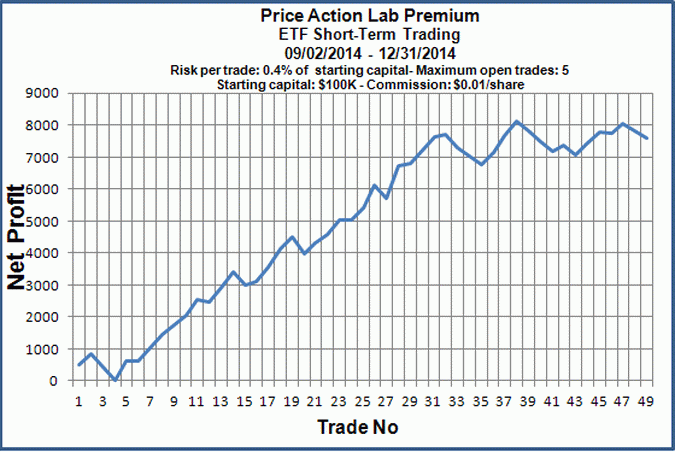The ETF short-term trading system was started on September 2, 2014 and achieved a net absolute return of 7.6% for the year with a total return for SPY in the same period of 4.9%. The performance was based on a fixed percent risk of 0.4% per trade and five open positions maximum, thus limiting total portfolio heat to 2% of starting capital.
Below is the equity curve followed by a table of a few key performance parameters:
Performance parameters
Trades: 50
Win rate 64%
Net profit 7,594
Net return 7.6%
Profit factor 2.54
Payoff ratio 1.42
Notes:
- Performance was volatile and flat after mid November due to increasing volatility
- Number of long trades: 11, Number of short trades: 39
- Traded ETFs: IYR, GLD, IBB, QQQ, SOCL, IWM, EEM, SMH, TAN, UNG, SLV, TLT, GDX, XLE, SPLV, SPHB, DIA, XLU, XLV
- The performance results are conservative due to the low risk percent per trade. Note that in many occasions results presented by various services are misleading because they assume fully invested equity on each position. When the proper allocation is applied, results may turn out to be dismal.
- Please note that success in trading depends mainly on three things: (a) a good timing method, (b) proper risk and money management and (c) discipline. The use of targets and stops applied in advance to each trade enforces (b) and (c).
- In the near future the maximum risk percent of 0.4% per position and the maximum of 5 positions may be both increased if conditions allow it.
- It is often not proper to assume a constant percent risk for each trade and size positions by dividing the allocated capital by the approximate entry price because stops should depend on technical levels. The appropriate determination of stop levels affects risk and thus position size. For example, depending on exit levels the number of shares traded could be much less than allowable number of shares based on allocated capital. Taking the absolute returns of securities and then compounding them to get the final performance is naïve, to say the least, and such action may be an indication of lack of a risk and money management framework in the case of discretionary trading, whether it is quantitative or not.
- The ETF short-term trading system used is based on quantitative analysis but it is not mechanical but discretionary in the sense that the selections of signals, risk percent and occasionally of exit levels depend on the author’s 25 year of experience with the markets and price action analysis. Quantitative analysis assists in determining probabilities, deciding if a pending setup must be cancelled or ignored but it does not suffice for achieving high performance results because it is based on descriptive statistics that ignore price action context and reflect longer-term averages, facts that often conflict with the objective of short-term returns.







